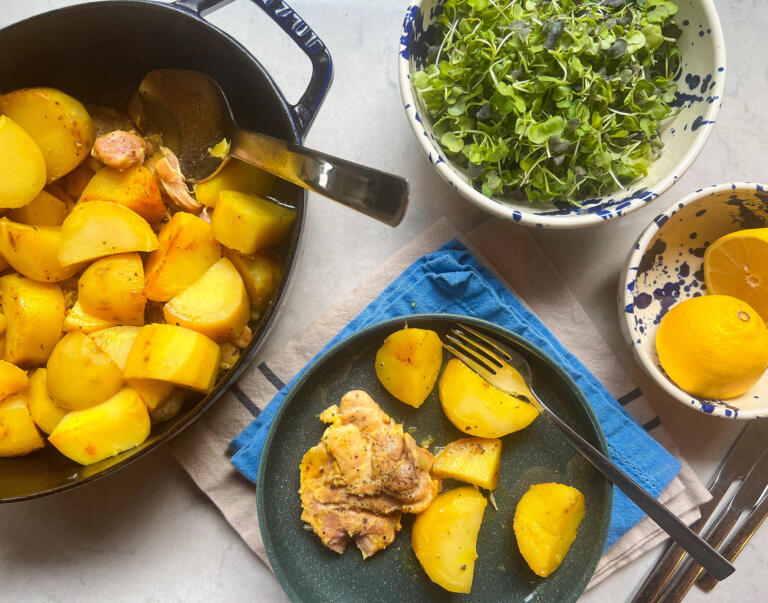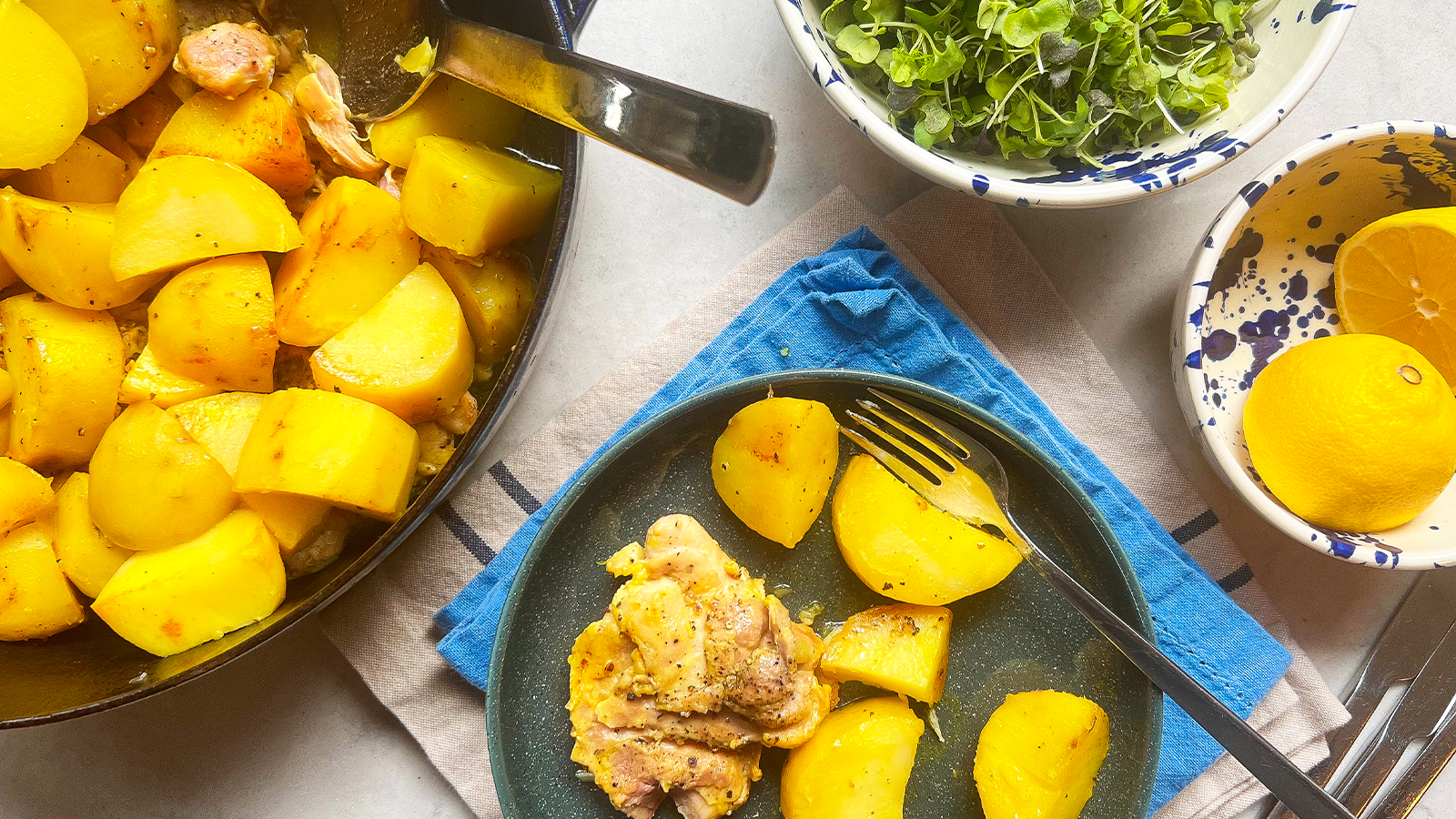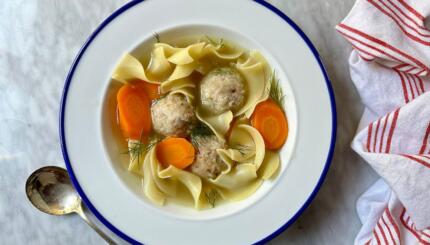Of all the dishes I’ve made for my family over the years, chicken and potato sofrito is probably the most popular, especially as the kids were growing up.
Sofrito is a Sephardi dish of meat (chicken, usually with the skin on, or beef chunks, seasoned with salt and pepper) and potatoes. It’s cooked for a long time on low heat with very little liquid. Traditionally, the potatoes are deep fried before they’re added to the meat. The occasional onion or root vegetable, such as carrots; squeeze of lemon juice; or pinch of cardamom and turmeric are added, but that’s about it. The slow cooking produces a concentrated sauce — the perfect example of a dish that’s larger than the sum of its simple ingredients.
And just to clarify: Sephardi sofrito should not be confused with the sofrito sauce of tomato, pepper and garlic that’s the base of many dishes in Latino, Spanish and Italian (where it is spelled soffritto) cuisines. Although, as we’ll see, all these versions are somehow related.
The word sofrito comes from the Catalan “sofregit” and Spanish “sofreír,” that mean to lightly fry something. According to Britannica.com, the origins of sofrito can be traced back to Catalonia, to a dish called sofregit. The dish emerged after new vegetables, such as carrots were introduced to the Iberian Peninsula by the Moors. The earliest recipe for sofregit appeared in the Catalan cookbook “Libre de Sent Soví,” circa 1324, and included onions, leeks, garlic and salt pork slowly cooked together.
The Nosher celebrates the traditions and recipes that have brought Jews together for centuries. Donate today to keep The Nosher's stories and recipes accessible to all.
It’s only after “discovering” the New World that tomatoes and peppers were added to the mix, which resulted in the sauce that’s so popular today. But by that time, the Jews had been expelled from the Iberian Peninsula. With the expulsion from Spain, Sephardi Jews emigrated to North Africa, parts of Europe and the Ottoman Empire, bringing the basic dish of lightly fried root vegetables and meat with them.
Some moved to modern day Israel in the 15th century, and even more during the 16th century after the Spanish Inquisition. They settled mainly in Jerusalem, Tiberias (where they called the dish sifrito), Safed (where it was sometimes known as sofrita) and Hebron. More Sephardi Jews arrived in the 19th century, mainly from Turkey and the Balkans.
“The Beauty Queen of Jerusalem,” a novel (and now a TV show on Netflix) by Sarit Yishai-Levi, follows four generations of the Sephardi Ermoza family in Jerusalem. Sephardi food descriptions are an essential part of the story, and among dishes such as hamin macaroni and biscochos, there is also mention of sofrito.
“My mother Luna passed away shortly before my eighteenth birthday. A year earlier, while the whole family was sitting around the table for lunch as usual and she was serving her famous sofrito with peas and white rice, she sat down on her chair and said, ‘Dio santo, I can’t feel my leg.’”
Matilda Koen-Sarano includes two sofrito recipes from Jerusalem in her Sephardi cookbook “Gizar kon Gozo” (Cooking with Ladino Flavors, written in Hebrew and Ladino). The first is a simple beef shoulder sofrito with nothing but potato, onion, oil, salt and pepper, which is the most popular version of the dish in Israel today. The second is made with chicken thighs, potatoes and many spices and taste agents, such as tomato paste and garlic.
In another Sephardi cookbook from Jerusalem, “The Cook from Agripas St.” (written in Hebrew), author Aviva Ben-Joseph includes three sofrito recipes. They’re all, in fact, different types of beef stews cooked with very little liquid on low heat; none of them contain potatoes or other vegetables.
Sofrito was also eaten by Sephardi Jews in Egypt. Cookbook author and food historian Claudia Roden includes two Egyptian sofrito recipes in “The Book of Jewish Food” from her own family: one with chicken and one with veal. She writes that the potatoes were originally deep fried before they were added to the pot with the meat, but says that her mother switched to tiny boiled new potatoes when the family moved to London. (The Jewish community as a whole left Egypt after the establishment of the state of Israel.)
In my house, sofrito means warm, satisfying homecoming. My version is as minimal as can be, and really easy to prepare. I use skinless, boneless chicken thighs, potatoes, oil, turmeric, salt and pepper, but you can use any cut of meat and add other root vegetables to the potatoes. Since both the chicken and the potatoes need the same cooking time, about one hour, I can fry the potatoes in the same dish as the chicken, adding even more flavor to the potatoes, and saving a dirty dish. I hope you’ll give it a go; maybe it will become your own family’s comfort dish, too.

Jerusalem Chicken Sofrito Recipe
This warm, satisfying chicken and potato dish is incredibly easy to make.
- Total Time: 1 hour 30 minutes
- Yield: Serves 6
Ingredients
- 2 lb boneless, skinless chicken thighs
- 3 tsp kosher salt, divided
- 1 tsp ground black pepper
- 4 Tbsp corn oil, or any neutral oil
- 8 medium gold potatoes (3-4 lb)
- ½ tsp turmeric
Instructions
- Arrange chicken thighs on a tray and sprinkle generously with 1½ tsp salt and 1 tsp pepper. Massage the salt and pepper into the chicken using your hands.
- Put 2 Tbsp oil in a heavy-bottom pot over medium-high heat. When the pot is very hot, brown chicken thighs on both sides, about 4 minutes per side. Brown the chicken in two batches to avoid crowding them too much. Transfer chicken thighs to a bowl.
- While the chicken is browning, prepare the potatoes: peel and cut in half lengthwise, then slice to ¾ inch thick slices.
- Add the rest of the oil to the empty pot, add potatoes and brown for about 5 minutes, stirring occasionally. Transfer to a bowl and mix with 1½ tsp salt, black pepper and turmeric.
- Lower the heat to very low. Arrange chicken at the bottom of the pot (keep the juices in the bowl) and top with potatoes. Make sure the potatoes cover the chicken completely. Drizzle chicken juices over the potatoes.
- Cover the pot tightly and cook for 1 hour. Since the chicken lets out juices, there’s no need to add any liquid to the pot, but you have to make sure you hear the simmer and see some liquid at the bottom of the pot. You can always add a couple of tablespoons of hot water if needed. Do not mix the stew, just swirl the pot from time to time and baste the potatoes 3-4 times during the cooking.
- When the stew is fully cooked, check the dish — the potatoes should be tender. If there is too much liquid in the pot (more than ½ inch, but it’s really up to your liking) you can continue to cook the sofrito for 10 more minutes uncovered, to let the sauce thicken. Remove pot from heat. Let stand for 10 minutes and serve.
- Prep Time: 10 minutes
- Cook Time: 1 hour 20 minutes
- Category: Dinner
- Method: Roasting
- Cuisine: Sephardic




Excellent one
Can this Chicken recipe be made in an Instant Pot?
Hi Susan, we haven’t tested this in an Instant Pot but if you try it please let us know how it turns out.
Could this be and for Instant Pot?
Hi Marcia, we haven’t tested this in an Instant Pot but if you try it please let us know how it turns out.
I’m curious to know what the greens are … and how they’re prepared.
Being a diabetic on insulin I need to restrict carb intake. Any suggestions on replacing the potatoes? Anyone tried other root vegetables?
Turnips.
How much time would you add if cooking bone in skin on thighs?
Hi Carrie, we’d suggest going ahead with the recipe as is and cooking for 1 hour. Check the internal temp of the chicken after that time and add more time accordingly.
Recipe calls for corn oil! NOT Pesadich.
Feel free to substitute with a KfP oil of your choice.
For Ashkenazi, not necessarily for Sephardi.
Thanks, from an Ashkenaz living in Portland, Or, born in Brooklyn and raised in the state of Confusion.
I’m anxious to try this recipe. It seems perfect for a slow cooker. I assume I cook for the same hour? Since I try to avoid fried food, is it necessary to fry/brown the chicken & the potatoes? Maybe only the potatoes?
Can you do this with chicken breasts rather than thighs, or would they not release enough juices?
You could use breasts but the risk is they’ll dry out, so we’d recommend checking them periodically through the cooking process.
This is amazingly good. I make it with half carrots (use the whole carrots sliced not baby carrots) and half potatoes.